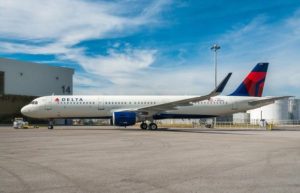In recent years, there has been a clear hierarchy among the U.S. legacy airlines in terms of profitability. Delta Air Lines (NYSE: DAL) has locked down the top spot, with American Airlines (NASDAQ: AAL) a distant second.
In recent weeks, American Airlines’ management has touted a plan to become more like Delta by operating more flights at its biggest hubs. By growing in Charlotte and Dallas-Fort Worth, the carrier hopes to improve its profitability. However, to properly replicate Delta’s strategy, American Airlines ought to be using larger planes at its biggest hubs — not just more of them.
There’s a wide margin gap today
In 2017, American’s adjusted pre-tax margin was 9.1%, compared to 13.2% for Delta Air Lines. (2017 wasn’t even a particularly good year for Delta.) Based on American Airlines’ earnings-per-share forecast for 2018, it appears that the margin gap relative to Delta may widen further this year.

American Airlines faces a large and growing margin gap relative to Delta. Image source: American Airlines.
Last fall, American Airlines CEO Doug Parker told investors that a big reason for the margin gap was that 40% of Delta’s flights touch its hub in Atlanta. Atlanta is the largest airline hub in the world and it is extremely profitable. Parker noted that American Airlines has a very strong hub nearby in Charlotte, but it accounts for a much smaller proportion of American’s total revenue.
Thus, Delta Air Lines has a structural margin advantage over American Airlines (and United Continental). That said, this structural advantage is not necessarily permanent, as other airlines could opt to focus more capacity in their best hubs as well. That’s exactly what American Airlines intends to do.
American Airlines tries for a fix
At a recent investor conference, American Airlines President Robert Isom stated that the carrier is working to get access to more gates in Dallas and Charlotte, its two largest hubs. In Dallas, American is investing $20 million to outfit a satellite concourse with 15 regional jet gates. These extra gates would allow it to operate nearly 900 departures from Dallas-Fort Worth International Airport on peak days, up from around 800 today.
American Airlines also hopes to expand in Charlotte, where the airport authority is in the midst of building nine new gates. This will enable American to add at least 50 peak day departures to its current total of almost 700.
Isom was careful to note that any growth would depend on market conditions. With fuel prices having spiked higher this year, American Airlines isn’t eager to add capacity right now. But once fares catch up with the recent fuel price increases — or if oil prices recede — American is likely to forge ahead with growth that is heavily concentrated in Dallas and Charlotte.
It’s not just about flight volume
Growing in Dallas and Charlotte should be profitable for American Airlines — but it isn’t likely to make much of a dent in the margin gap vis-a-vis Delta. That’s because operating more than 1,000 peak day flights is only one piece of Delta’s formula for success in Atlanta. The other key to Atlanta’s profitability is that Delta uses larger, more efficient aircraft than its rivals.
Indeed, while American Airlines is only slightly larger than Delta Air Lines in terms of revenue, it has almost 600 regional jets in its fleet, compared to just 460 for Delta. This difference in the fleet mix for the two carriers shows up in the number of passengers moved through their largest hubs.
Delta carried 83 million passengers in Atlanta last year, compared to 57 million for American Airlines in Dallas. This is a 46% advantage for Delta, which is significantly larger than the difference in the number of daily departures for the two carriers at their largest hubs. In Charlotte, American Airlines uses even smaller planes (on average) than it does in Dallas.

Delta’s hub in Atlanta is by far the largest airline hub in the U.S. Image source: Delta Air Lines.
Mainline aircraft are cheaper to operate on a per-seat basis than regional jets. Delta’s ability to drive enough passenger traffic through Atlanta to support larger jets on most routes is critical to its superior profitability there.
In Charlotte, the small size of the local market and competition from Delta’s nearby Atlanta hub may make it impossible to introduce larger aircraft in a significant way. By contrast, the Dallas-Fort Worth metro area is even bigger than Atlanta and American’s hub there is by far the largest airline hub in that part of the U.S. While adding more flights there is a good idea, American Airlines should also look to upgrade as many routes as possible to mainline service. That will help it maximize the profit it generates in its largest and most productive hub.


